Plus One Zoology Chapter Wise Questions and Answers Chapter 6 Breathing and Exchange of Gases is part of Kerala Plus One Zoology Chapter Wise Questions and Answers. Here we have given Plus One Zoology Chapter Wise Questions and Answers Chapter 6 Breathing and Exchange of Gases.
Kerala Plus One Zoology Chapter Wise Questions and Answers Chapter 6 Breathing and Exchange of Gases
Plus One Breathing and Exchange of Gases One Mark Questions and Answers
Question 1.
Respiration in insects is called direct because
(a) The tissues exchange O2/ CO2 directly with the air in the tubes.
(b) The tissues exchange O2/ CO2 directly with coelomic fluid.
(c) The tissues exchange O2/ CO2 directly with the air outside through body surface.
(d) Tracheal tubes exchange O2/ CO2 directly with the haemocoel which then exchange with tissues.
Answer:
(d) Tracheal tubes exchange O2/ CO2 directly with the haemocoel which then exchange with tissues.
Question 2.
Mark the true statement among the following with reference to normal breathing
(a) Inspiration is a passive process where as expiration is active
(b) Inspiration is an active process where as expiration is passive
(c) Inspiration and expiration are active processes
(d) Inspiration and expiration are passive processes
Answer:
(b) Inspiration is an active process where as expiration is passive
Question 3.
Inspiration and expiration are passive processes A person breathes in some volume of air by forced inspiration after having a forced expiration. This quantity of air taken in is
(a) Total lung capacity
(b) Tidal volume
(c) Vital capacity
(d) Inspiratory capacity
Answer:
(c) Vital capacity
Question 4.
Incidence of Emphysema – a respiratory disorder is high in cigarette smokers. In such cases
(a) The alveolar walls are found damaged
(b) The plasma membrane is found damaged
(c) The bronchioles are found damaged
(d) The respiratory muscles are found damaged
Answer:
(b) The plasma membrane is found damaged
Question 5.
Respiratory process is regulated by certain specialized centres in the brain. One of the following listed centres can reduce the inspiratory duration upon stimulation.
(a) Medullary inspiratory centre
(b) Pneumotaxic centre
(c) Apneustic centre
(d) Chemosensitive centre
Answer:
(b) Pneumotaxic centre
Question 6.
CO2 + H2O → H2CO3 → HCO3– + H+
These all the reactions that takes place in accordance with respiration.
- Where these reactions takes place
- Which is the enzyme present here?
Answer:
- In blood
- Carbonic anhydrase
Question 7.
Fill in the table with appropriate heading values.

Answer:
- a – Blood (Deoxygenated)
- b – Blood (oxygenated)
- c – 40
- d – 45
Question 8.
In the following diagram, A represents Total lung capacity and B represents Vital capacity and then C represents what?
![]()
Answer:
C – Residual volume
Question 9.
Name the biological principle involved in the exchange of gas between lungs and blood.
(Transmittance, Osmosis, Diffusion, Incorporation)
Answer:
Diffusion
Question 10.
What is the percentage of oxygen transported by Haemoglobin in the form of Oxyhaemoglobin? (67%, 97%, 32%, 50%)
Answer:
97%
Plus One Breathing and Exchange of Gases Two Mark Questions and Answers
Question 1.
Complete the flow chart showing inspiration
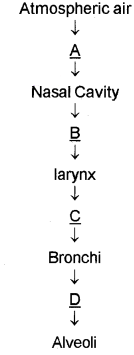
Answer:
- A – Nasal opening
- B – Nasopharynx
- C – Trachea
- D – Bronchiole
Question 2.
Oxyhaemoglobin → Oxygen + Hb
- Where does this process take place?
- What are the factors that influence the O2 dissociation curve?
Answer:
- In tissues
- pO2, pCO2, H+ concentration, temperature.
Question 3.
The given diagram shows the exchange of gases between the alveolus and alveolar-capillary.
- Identify X and Y.
- Name the Physical Process involved in gas exchange.
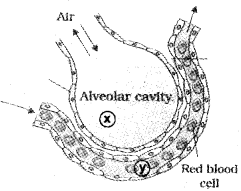
Answer:
- X – CO2, Y – O2
- Diffusion
Question 4.
Bar diagram showing oxygen transport is shown below.
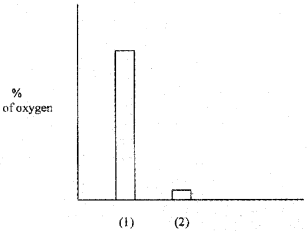
- Name the two methods of oxygen transport.
- How much oxygen is transported in method 1 and method 2.
Answer:
- Methods of oxygen transport
- O2 is transported by RBC in the blood (oxyhaemoglobin).
- O2 is transported in a dissolved state through plasma.
- About 97% of O2 is transported as oxyhemoglobin and remaining 3% is carried in a dissolved state through the plasma.
Question 5.
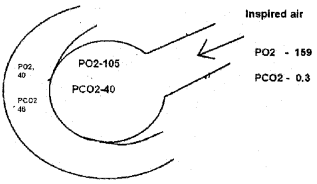
From this diagram prepare a table which show the pressure difference in various regions in respiration.
Answer:

Question 6.
Match the following.
| Prawn | Skin |
| Cockroach | Lungs |
| Viper | Gills |
| Earthworm | Trachea |
Answer:
| Prawn | Gills |
| Cockroach | Trachea |
| Viper | Lungs |
| Earthworm | Skin |
Question 7.
‘Emphysema’ is a term linked with ‘Respiratory system’. What is emphysema?
Answer:
Emphysema is respiratory system disorder in which alveolar walls are damaged due to which respiratory surface is decreased. Cigarette smoking is one of the major cause of emphysema.
Question 8.
Draw a flow chart showing the air passage in the human respiratory system.
(Trachea, nasal cavity, nasopharynx, bronchi, nostrils, alveoli, bronchioles, larynx)
Answer:
Nostrils → nasal cavity → nasopharynx → larynx alveoli ← branchioles ← bronchi ← Trachea.
Question 9.
Study the graph and answer the following questions.

- What is represented by the graph?
- Find out the pressure at which Haemoglobin is 50% saturated with O2?
Answer:
- Oxygen dissociation curve
- 28 mm Hg
Question 10.
- Name the structural and functional unit of lungs.
- Why the lungs replaces the skin in Mammals as respiratory organ.
Answer:
- Alveoli
- Lungs contain millions of alveoli which serves to store oxygen and it is richly supplied with blood capillaries. These alveolar surface area exceeds the skin.
Question 11.
The pO2 in cell cytoplasm is always lower than the capillary blood while pCO2 is greater. How do you account for this?
Answer:
In the cell cytoplasm, as a result of metabolism, the CO2 accumulates and oxygen content is reduced. So pO2 in cell cytoplasm is always lower than the capillary blood.
Question 12.
A dog expires CO2. How can you correlate the relationship between the dog and grazing cattle in terms of CO2.
Answer:
Dog expires CO2 to atmosphere and it is utilised by grass during photosynthesis and that grass is utilised by cattle.
Question 13
Observe the pie diagram given below and answer the following questions.
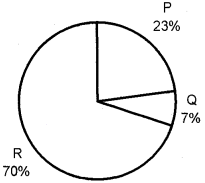
Figure showing the percentage of carbon dioxide transport.
- What are the three methods of CO2 transport mentioned by the letters P, Q, R?
- If the amount of Haemoglobin in the blood of a patient is very low. What changes do you expect in the processes?
Answer:
- Methods of CO2 transport
- P – Carbamino haemoglobin in combination with an amino group of protein.
- Q – Carbonic acid dissolved in plasma
- R – as bicarbonates
- Reduce the formation of carbaminohaemoglobin and formation of bicarbonates also reduces.
Question 14.
Find the odd one in each group in Column Awrite in Column B and write the reason in Column C.
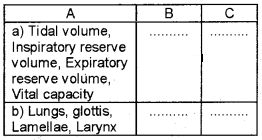
Answer:
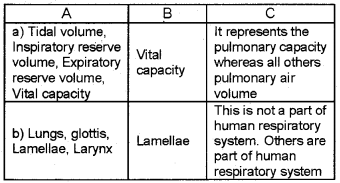
Question 15.
Analyse the concept map given below and if have mistakes reconstruct it.
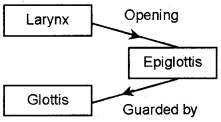
Answer:
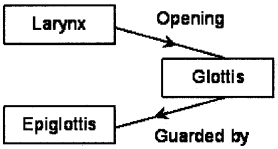
Question 16.
A person exhaled nearly more than 3000ml of air during a breathing exercise. How do you justify that act?
Answer:
During breathing excercise one can exhale the air nearly of his vital capacity which averages to 3500ml. During normal respiration only tidal volume (500ml) is exhaled.
Question 17.
In orderto give the awareness about healthy practices to reduce respiratory disorders, prepare a pamphlet.
Answer:
- Bronchitis, Bronchial asthma, Emphysema, Pneumonia, occupational lung disease are some respiratory disorders.
- Stop cigarette smoking to prevent emphysema, bronchitis and bronchial asthma.
- Use protective clothes and gears in work places to prevent occupational lung diseases.
- Regular health check-up, use of antibiotic drugs and bronchodilator drugs by the advice of doctor.
Question 18.
The venous blood in the lungs has a pCO2 of 46mm Hg. Should the alveolar pCO2 exceeds or be less than 46mm Hg to result in diffusion of CO2 from the blood into alveolus?
Answer:
The alveolar pCO2 must be less than 46mm Hg. Then only there will be difference in the partial pressure and diffusion occurs from the higher concentration to a lower concentration.
Question 19.
Human respiration is controlled by intercostal muscles in the ribs and diaphragm. Justify this statement.
Answer:
Human respiration is controlled by the contraction and relaxation of intercostal muscles in the ribs. Due to the contraction the thoracic space increases and the atmospheric air comes inside to maintain the pressure.
When intercostal muscles relax the thoracic volume reduces and due to high pressure the air expels outward. This is known as expiration.
Question 20.
Observe the figure explaining difference in partial pressure of oxygen in different parts of body.
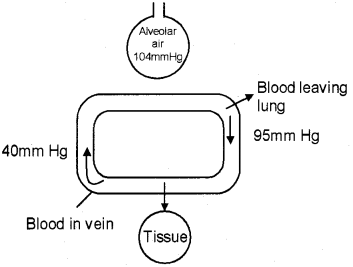
- Explain the importance of partial pressure of oxygen in the gas exchange.
- What may be the partial pressure of oxygen in the tissue for effective gas transport?
Answer:
- Difference in the partial pressure of oxygen in the alveolar air and in the blood results in the exchange of gases by simple diffusion.
- The partial pressure of oxygen in the tissue is less than 90mm Hg.
Question 21.
While analysing the blood of normal healthy person, it has been found that the amount of HCO3– ions in his venous blood is much higher than his arterial blood. How do you account for this increase of HCO3– ions.
Answer:
The amount of CO2 in venous blood is much higher than that of arterial blood. Since major portion of CO2 is transported through blood as HCO3– ions. The amount of HO3– remains high in venous blood.
Question 22.
Place the following in the correct order.
Lungs expand, rib rise, air enters lungs, external intercostal muscle contract, thorax expands.
Answer:
External intercostal muscle contract → rib rise Lungs expand ← Thorax expands air enters lungs.
Question 23.
Pneumatoxic centre has an important role in regulating rate of respiration. Prepare a flow chart representing the regulation of respiration by pneumatoxic centre during strenuous exercise.
Answer:
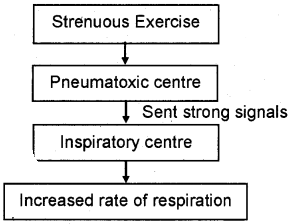
Plus One Breathing and Exchange of Gases Three Mark Questions and Answers
Question 1.
Transport of CO2 as Bicarbonates.
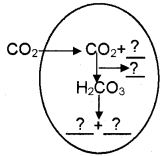
- Copy the diagram and fill the gaps.
- Name the other ways of CO2 transport.
- If blood chlorine level decreases, does it affect gas transport? Justify.
Answer:
1.
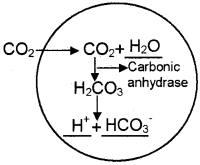
2. Other ways of CO2 transport:
- Carbamino haemoglobin
- Carbonic acid
3. Yes. Decrease in chloride level affects CO2 transport. During CO2 transport bicarbonate ions formed within the erythrocytes (RBC) diffuse out into the plasma. It upsets the ionic equilibrium and electrical balance between RBC and plasma.
To regain the lost balance an equal number of chloride (Cl ) ions diffuse into RBC from plasma. This is called chloride shift or Hamburger phenomenon.
Question 2.
Analyse the flow chart.
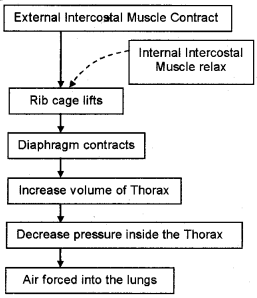
- Distinguish the function of external and internal intercostal muscles.
- Draw a flow chart explaining inspiration.
Answer:
1. During inspiration external intercostal muscle contracts and internal intercostal muscle relaxes. External intercostal muscle and internal intercostal muscles are antagonistic in action
2.

Question 3.
Pharynx is a common passage for air and food.
- Name the part for the passage of food.
- Name the part for the passage of air.
- How do this passagework without any problems?
Answer:
- Oropharynx
- Nasopharynx
- Glottis is the opening of the nasopharynx into the trachea. During swallowing, the glottis can be covered by a thin elastic cartilaginous flap called epiglottis to prevent the entry of food into the larynx.
Question 4.
The following figure shows a microscopic section through the alveoli in the lungs of man.

Give the features visible in the diagram that help to increase the rate of diffusion across the wall of the alveoli into the blood.
Answer:
- Surface area is increased by alveoli.
- Presence of capillaries
- Thin wall helps to increase the rate of diffusion. (The diffusion membrane is made up of three layers namely the thin squamous epithelium of alveoli, the endothelium of alveolar capillaries and the basement substance in between)
Question 5.

- Which of the above graph represents normal condition?
- What would be the reason of abnormality of graph?
- What are the symptoms shown in such condition?
Answer:
- ‘A’ represents normal condition.
- The abnormality is due to the low pO2 in blood.
- The symptoms include headache, nausea, dizziness and even death.
Question 6.
A person inhales to his maximum capacity and then he exhales also to his maximum.
- What term would you use for the volume of air thus breathed out.
- What is the volume of air thus breathed out?
- Suppose he hold his breath after that maximum expiration for 5 seconds would there be any exchange of respiratory gases occuring in lungs during that period. How?
Answer:
- Vital capacity
- 3.5 – 4.5 litres
- Yes. Because of residual volume. The volume of air that still remains in the lungs after a forceful expiration is called residual volume. It is about 1500ml in man.
Question 7.
Human beings have a significant ability to maintain and moderate the respiratory rhythm to suit the demand of body tissues-substantiate.
Answer:
This is done by the neural system. A specialised centre present in the medulla region of the brain called respiratory rhythm centre is primarily responsible for this regulation. Another centre present in the pons region of the brain called pneumotaxic centre can moderate the functions of the respiratory rhythm centre.
Neural signal from this centre can reduce the duration of inspiration and thereby alter the respiratory rate. Achemosensitive area is situated adjacent to the rhythm centre which is highly sensitive to CO2 and hydrogen ions.
Increase in these substances can activate this centre and make necessary adjustments in the respiratory process. Receptors associated with aortic arch also send necessary signals to the rhythm centre to adjust respiratory rate.
Question 8.
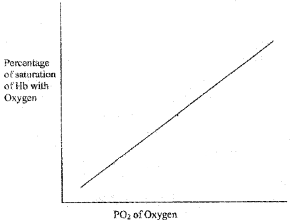
- Redraw the graph to correct the mistake
- Name the graph
- Which are the factors that affect this graph.
Answer:
1.

2. Oxygen dissociation curve
3. pO2, pCO2, H+ concentration, and temperature are the factors that affect the oxygen dissociation curve.
Plus One Breathing and Exchange of Gases NCERT Questions and Answers
Question 1.
Define vital capacity. What is its significance?
Answer:
Vital capacity (VC):
The maximum volume of air a person can breathe in after forced expiration. This includes ERV (Expiratory Reserve Volume), TV (Tidal volume), and IRV (Inspiratory Reserve volume) of the maximum volume of air a person can breathe out after a forced inspiration.
Question 2.
State the volume of air remaining in the lungs after normal breathing.
Answer:
Functional Residual Capacity (FRC). The volume of air that will remain in the lungs after a normal expiration.
This includes ERV + RV
ERV = 1000 to 1100ml
RV= 1100 to 1200ml
FRC = 2100 to 2300ml
Question 3.
What are the major transport mechanisms for CO2? Explain.
Answer:
Transport of Carbon dioxide CO2 is carried by hemoglobin as carbamino-hemoglobin (about 20-25 percent). This binding is related to the partial pressure of CO2, pO2 is a major factor which could affect this binding.
When pCO2 is high and pO2 is low as in the tissues, more binding of carbon dioxide occurs whereas, when the pCO2 is low and pO2 is high as in the alveoli, dissociation of CO2 from carbamino- hemoglobin takes place, i.e., CO2 which is bound to Haemoglobin from the tissues is delivered at the alveoli.
RBCs contain a very high concentration of enzyme, carbonic anhydrase and minute quantities of the same is present in the plasma too. This enzyme facilitates the following reaction in both directions

At the tissue site where the partial pressure of CO2 is high due to catabolism, CO2 diffuses into blood (RBCs and plasma) and forms HCO3 and H+. At the alveolar site where pCO2 is low, the reaction proceeds in the opposite direction leading to the formation of CO2 and H2O.
Thus CO2 trapped as bicarbonate at the tissue level and transported to the alveoli is released out as CO2. Every 100 ml of deoxygenated blood delivers approximately 4ml of CO2 to the alveoli.
Question 4.
What will be the pO2 and pCO2 in the atmospheric air compared to those in the alveolar air?
(i) pO2 lesser, pCO2 higher
(ii) pO2 higher, pCO2 lesser
(iii) pO2 higher, pCO2 higher
(iv) pO2 lesser, pCO2 lesser
Answer:
(ii) pO2 higher will create the pressure gradient to facilitate the movement of O2 from atmosphere to alveoli and pCO2 lesser will create the movement of CO2 from alveoli to atmosphere.
Question 5.
What is the effect of pCO2 on oxygen transport?
Answer:
Binding of oxygen with haemoglobin is primarily related to partial pressure of O2. Partial pressure of CO2, hydrogen ion concentration and temperature are the other factors which can interfere with this binding. Increased partial pressure of CO2 can increase haemoglobin’s affinity towards oxygen and vice-versa is also true.
Question 6.
What happens to the respiratory process in a man going up a hill?
Answer:
When a man going uphill or doing some strenuous exercise then there is more consumption of oxygen. This decreases the partial pressure of oxygen in haemoglobin resulting in more demand of haemoglobin. As a result there is an increased breathing rate to fill the gap.
Plus One Breathing and Exchange of Gases Multiple Choice Questions and Answers
Question 1.
Which one is the cofactor of carbonic anhydrase?
(a) Iron
(b) Zinc
(c) Copper
(d) Magnesium
Answer:
(b) Zinc
Question 2.
Skin is an accessory organ or respiration in
(a) human
(b) frog
(c) rabbit
(d) lizard
Answer:
(b) frog
Question 3.
Which of the following respiratory organs are present in spiders and scorpions?
(a) gill slit
(b) Gills
(c) Gill books
(d) Book lungs
Answer:
(d) Book lungs
Question 4.
When the body is rapidly oxidising fats, excess ketone bodies accumulate resulting in
(a) pyruvic acid
(b) lactic acid
(c) ketoacidosis
(d) ATP
Answer:
(c) ketoacidosis
Question 5.
Oxygen dissociation curve is
(a) sigmoid
(b) parabolic
(c) hyperbolic
(d) straight line
Answer:
(a) sigmoid
Question 6.
Which one of the following statements is incorrect?
(a) The residual air in lungs slightly decreases the efficiency of respiration in mammals
(b) The presence of non-respiratory air sacs, increases the efficiency of respiration in birds
(c) In insects, circulating body fluids serve to distribute oxygen to tissues
(d) The principle of countercurrent flow facilitates
Answer:
(a) The residual air in lungs slightly decreases the efficiency of respiration in mammals
Question 7.
Haemoglobin is having maximum affinity with
(a) carbon dioxide
(b) carbon monoxide
(c) oxygen
(d) ammonia
Answer:
(b) carbon monoxide
Question 8.
Which is called Hamburger shift?
(a) Hydrogen shift
(b) Bicarbonate shift
(c) Chloride shift
(d) Sodium shift
Answer:
(c) Chloride shift
Question 9.
Left shift of oxyhaenoglobin curve is noticed under
(a) normal temperature and pH
(b) low temperature and high pH
(c) low pH and high temperature
(d) low pH and low temperature
Answer:
(b) low temperature and high pH
Question 10.
Read the following statements and select the correct one.
(a) The H+ released from carbonic acid combines with haemoglobin to form haemoglobinic acid
(b) Oxyhaemoglobjn of erythrocytes is alkaline
(c) More than 70% of carbon dioxide is transferred from tissues to the lungs in the form of carbamino compounds
(d) In a healthy person, the haemoglobin content is . more than 25gm per 100mL
Answer:
(a) The H+ released from carbonic acid combines with haemoglobin to form haemoglobinic acid
Question 11.
In blood, carbon dioxide is transported majorly as
(a) sodium carbonate
(b) carboxyhaemoglobin
(c) bicarbonate
(d) carbon dioxide as such
Answer:
(c) bicarbonate
Question 12.
Most of the carbon dioxide is transported in blood as a gas
(a) gas
(b) carbaminohaemoglobin
(c) serum carbaminoproteins
(d) HCO3
Answer:
(b) carbaminohaemoglobin
Question 13.
How many molecules of oxygen can bind to a molecule of haemoglobin?
(a) One
(b) Two
(c) Three
(d) Four
Answer:
Question 14.
When carbon dioxide concentration in blood increases, breathing becomes
(a) shallower and slow
(b) there is no effect on breathing
(c) slow and deep
(d) faster and deeper
Answer:
Question 15.
The total number of lobes and alveoli present in both the lungs of man are
(a) 17 and 30 million, respectively
(b) 5 and 300 million, respectively
(c) 19 and 300 million, respectively
(d) 18 and 300 lakh, respectively
Answer:
(b) 5 and 300 million, respectively
Question 16.
What is vital capacity of our lungs?
(a) Inspiratory reserve volume plus tidal volume
(b) Total lung capacity minus expiratory reserve volume
(c) Inspiratory reserve volume plus expiratory reserve volume
(d) Total lung capacity minus residual volume
Answer:
(c) Inspiratory reserve volume plus expiratory reserve volume
Question 17.
When the oxygen supply to the tissues is inadequate, the condition is
(a) hypoxia
(b) asphyxia
(c) pleurisy
(d) anoxia
Answer:
(a) hypoxia
Question 18.
Severe Acute Respiratory Syndrome (SARS)
(a) is caused by a variant of Pneumococcuspneumoniae
(b) is caused by a variant of the common cold virus (coronavirus)
(c) is an acute form of asthma
(d) affects non-vegetarians much faster than
Answer:
(b) is caused by a variant of the common cold virus (coronavirus)
Question 19.
During inspiration, the diaphragm
(a) expands
(b) shows no change
(c) contracts and flattens
(d) relaxes to become dome-shaped
Answer:
(c) contracts and flattens
Question 20.
The oxygen toxicity is related to
(a) blood poisoning
(b) collapsing of alveolar walls
Answer:
(c) failure of venti
We hope the Kerala Plus One Zoology Chapter Wise Questions and Answers Chapter 6 Breathing and Exchange of Gases help you. If you have any query regarding Kerala Plus One Zoology Chapter Wise Questions and Answers Chapter 6 Breathing and Exchange of Gases, drop a comment below and we will get back to you at the earliest.
